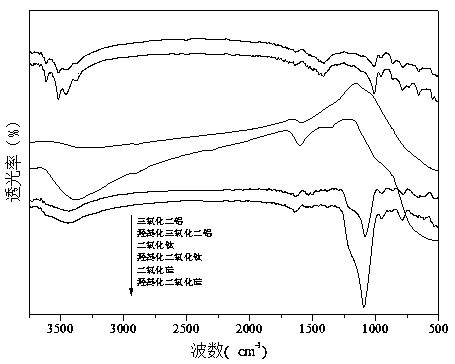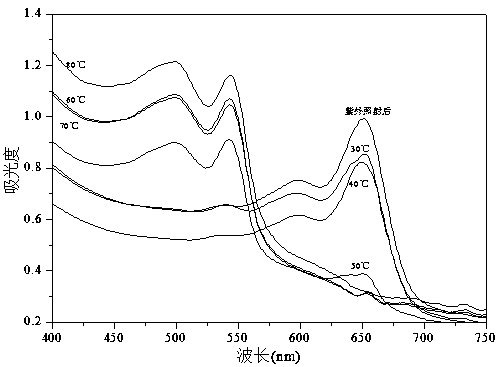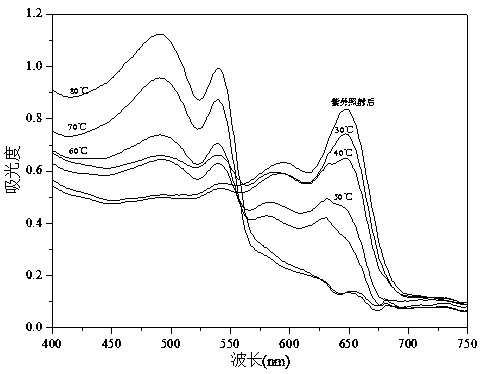Polydiacetylene-based thermotropic reversible color-change composite material and preparation method thereof
A composite material, diacetylene technology, applied in the direction of color-changing fluorescent materials, chemical instruments and methods, etc., can solve the problem that the color cannot be restored from red to blue state, affecting the reusability of polydiacetylene sensors, etc. control effect
- Summary
- Abstract
- Description
- Claims
- Application Information
AI Technical Summary
Problems solved by technology
Method used
Image
Examples
Embodiment 1
[0021] Example 1. Preparation of polydiacetylene / hydroxyaluminum oxide composite material
[0022] (1) Preparation of hydroxylated aluminum oxide: Weigh 3 g of aluminum oxide and add it to 30 ml of H 2 O 2 / H 2 O mixed solution (H 2 O 2 :H 2 O=1:2~1:3v / v), add sodium silicate to adjust the pH of the solution to 10, react at 50 °C for 5~7 h, filter, and wash the solid with deionized water several times until the eluate is medium After drying in vacuum, hydroxylated aluminum oxide is obtained; the infrared spectra of hydroxylated aluminum oxide and unhydroxylated aluminum oxide are shown in figure 1 .
[0023] (2) Preparation of polydiacetylene / hydroxylated aluminum oxide composite material: Weigh 12 g of 10,12-pentacosadiynoic acid monomer, add it to 1 mL of dimethyl sulfoxide and stir to fully dissolve it Then add 9 mL of deionized water, ultrasonically disperse for 10 min, add to the deionized aqueous solution of 3 mg of hydroxylated aluminum oxide above, mix and ultr...
Embodiment 2
[0025] Example 2. Preparation of polydiacetylene / hydroxylated titanium dioxide composite material
[0026] (1) Preparation of hydroxylated aluminum oxide: Weigh 3 g of titanium dioxide particles and add them to 30 ml of H 2 O 2 / H 2 O mixed solution (H 2 O 2 :H 2 O=1:2~1:3v / v), add sodium silicate to adjust the pH of the solution to 10, react at 50 °C for 5~7 h, filter, and wash the solid with deionized water several times until the eluate is medium After drying in vacuum, hydroxylated titanium dioxide is obtained; the infrared spectra of hydroxylated titanium dioxide and unhydroxylated titanium dioxide are shown in figure 1 .
[0027] (2) Preparation of polydiacetylene / hydroxylated titanium dioxide composite material: Weigh 12 g of 10,12-pentacosadiynoic acid monomer, add it to 1 mL of dimethyl sulfoxide and stir to fully dissolve it, and then add 9 mL of deionized water, ultrasonically dispersed for 10 min, added to the deionized aqueous solution of the above 3 mg of...
Embodiment 3
[0029] Example 3. Preparation of polydiacetylene / hydroxylated silica composite material
[0030] (1) Preparation of hydroxylated silica: Weigh 3 g of silica particles and add them to 30 ml of H 2 O 2 / H 2 O mixed solution (H 2 O 2 :H 2 O=1:2~1:3v / v), add sodium silicate to adjust the pH of the solution to 10, react at 50 °C for 5~7 h, filter, and wash the solid with deionized water several times until the eluate is medium After drying in vacuum, hydroxylated silica is obtained; the infrared spectra of hydroxylated and unhydroxylated silica are shown in figure 1 .
[0031] (2) Preparation of polydiacetylene / hydroxylated silica composite material: Weigh 12g of 10,12-pentacosadiynoic acid monomer, add it to 1 mL of dimethyl sulfoxide, stir to fully dissolve it, and then add 9 mL deionized water, ultrasonically dispersed for 10 min, added to the deionized aqueous solution of 3 mg of hydroxylated silica above, mixed and then ultrasonically shaken at 75-80 °C for 50 min, (th...
PUM
 Login to View More
Login to View More Abstract
Description
Claims
Application Information
 Login to View More
Login to View More - R&D
- Intellectual Property
- Life Sciences
- Materials
- Tech Scout
- Unparalleled Data Quality
- Higher Quality Content
- 60% Fewer Hallucinations
Browse by: Latest US Patents, China's latest patents, Technical Efficacy Thesaurus, Application Domain, Technology Topic, Popular Technical Reports.
© 2025 PatSnap. All rights reserved.Legal|Privacy policy|Modern Slavery Act Transparency Statement|Sitemap|About US| Contact US: help@patsnap.com



